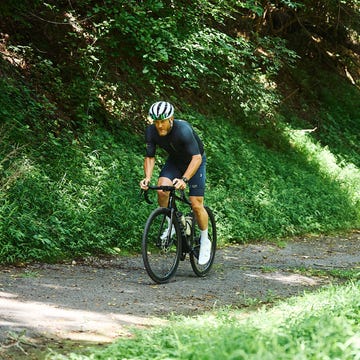When cyclists hear Enve's name, they usually think of fancy U.S.-made carbon wheels, forks, and bars. But with its sponsorship of the Team TotalEnergies World Tour squad and the launch of a fourth frameset, it’s probably time to think of Enve as a bicycle brand.
Enve returned to its boutique roots in 2021 with a product that few outside the company saw coming—a custom carbon road frame manufactured at Enve’s Ogden, Utah headquarters. Then, in 2022, Enve launched a production model road bike called the Melee. A year later, in 2023, Enve launched its MOG gravel bike. And in 2024, the brand releases the Fray.
The distinction between Enve’s first three bikes is clear. The Custom Road is a boutique frame that emphasizes ride quality and craftsmanship. The Melee is best described as a production road race bike similar to a Specialized Tarmac or Cannondale Super Six Evo.
The Fray is more difficult to define than Enve’s previous models. It fits somewhere between the MOG and the Melee. It’s a space many brands have previously played, some with success but others with real misses. First, let me assuage any concerns. The Fray is not a miss—it’s a wonderful bike that checks many boxes and will be the right bike for many riders.
What Does “Endurance Bike” Mean Anymore?
Bikes that fill the space between dedicated road and gravel bikes are often termed all-road or endurance bikes. But other names for this style of bike pop up every few years or are proposed by brands’ marketing teams. As my colleague Matt Phillips describes, when Specialized launched its first Roubaix models in 2004 (arguably the first production endurance bike), someone at the Bicycling termed it “plush road.” The basic premise of the category over the last two decades has essentially been to take a road bike, add a bit of tire clearance, give it lower gearing, and tweak the geometry to make it somewhat more upright and comfortable.
It sounds simple and appealing enough, but as road bikes became more capable (with increased tire clearance, disc brakes, and wide-range gearing) over the years, the appeal of this middle ground has diminished for many. The main drawback of these all-road or endurance category bikes is that brands stripped away too much of what I liked and wanted from a road bike in a quest for versatility.
That’s precisely why I am so smitten by the Fray. Here is a bike optimized around 31 to 35mm tires but with clearance for up to 40mm (in a 1x configuration, max 2x clearance is 38mm), which honestly feels conservative. It’s also impressively light at 17 pounds with tires measuring 38mm and deep-section Enve aero wheels. While these numbers are impressive, the two things that clinched the Fray for me were how it rode, which is like a road bike—Confidence-inspiring, precise, and dynamic.
The Fray looked so much like the Melee that, from a distance, the bikes were virtually identical. The only visual giveaways are the top tube and down tube mounts, the internal storage hatch, the fork brake mount using an adapter plate, and some very minor tube shaping differences that honestly wouldn’t be perceptible unless you had the two bikes next to each other.
Appearance is subjective, and if you didn’t like how the Melee looks, you probably won’t be into the Fray. But I think it’s good that Enve matched the styling of the two bikes. After all, there is a desire from consumers to ride what the pros are racing, it is why race bikes are so popular, even among riders who don’t compete.
Fray-me Details and Pricing
Fray’s feature list reads like a wish list for riders seeking a do-it-all dropbar bike. The full carbon frame and fork are pleasantly free of dumb standards. The front end is fully integrated using Enve’s IN-Route system, the same system used on Enve’s three other bikes and several other brands. This means riders have a broad range of choices for handlebars and stems. Enve also ships a “by-pass” spacer with the Fray, allowing riders to set up a cockpit that runs the hoses externally of the bar and stem. The seatpost is the same D-shaped post that is used on the Melee.
As previously noted, the Fray clears a 38mm tire with a 2x drivetrain and a 40mm tire if set up 1x. Based on my test bike with 38mm (measured) tires, this sizing is conservative, with 8mm of space to spare.
The Fray is compatible with electronic groupsets (except Campagnolo EPS) and with Shimano mechanical 2x and 1x drivetrains. The frame is incompatible with SRAM or Campy 2x mechanical systems due to the frame needing continuous cable housing to the front derailleur (but any 1x mechanical drivetrain will work just fine). Enve continued using the T47 bottom bracket standard for creek-free performance and nearly universal crank compatibility.
The Fray uses a SRAM UDH rear derailleur hanger, which makes replacement hangers easy to find. However, the Fray is not compatible with a SRAM T-Type mullet setup because SRAM recommends a minimum chainstay length of 425mm, while the Fray uses lengths between 415 and 420mm.
For carrying capacity, the Fray uses the same Enve Cargo Bay that features on the MOG gravel bike. It has a total carrying capacity of 36 cubic inches, spread out over two neoprene bags that can be used to carry tools or flat repair supplies. Additionally, the frame has mounts for a top tube feed bag and a third bottle cage under the down tube.
Enve sells the Fray as a chassis for $5,500 in three colors and seven frame sizes. That price includes the frameset, stem, handlebar, and seatpost. To help riders dial in their fit and pick the appropriate stem length, spacer stack, and seatpost offset, Enve offers a widget called the “Best-Fit Calculator” on its website. Riders can measure an existing bike or start with a professional bike fit.
The Fray’s Geometry
Compared to the Melee race bike, the Fray has a 20mm higher stack, a 6mm shorter reach, and a 16mm longer wheelbase. But when you compare the Fray to other bikes in the endurance category—such as the Specialized Roubaix SL8, Trek Domane, Giant Defy, Cannondale Synapse, and Canyon Endurace—it becomes apparent that while the Fray shares a similar stack height (except for the Roubaix which is the tallest of the bunch by far), it’s just a hair longer than all of these bikes.
These differences might seem trivial, but modern road bike geometry is a game of millimeters.
Enve offers the Melee in seven frame sizes, from 47cm to 60cm. What’s most notable here is that Enve used five different fork rakes across the size range. This detail ensures that riders of the smallest and largest sizes get the same handling characteristics as riders in the middle of the size range. Most brands avoid using this many different forks for their bikes (to save cost or development time) and use the same model across entire size ranges.
I also give Enve kudos for including not only one trail figure but four on its geometry chart (for various tire sizes). It’s a nice detail and a handy reminder to riders that they can tune the handling of their bike by changing to a larger or smaller tire size.
Ride Impressions
All-road or endurance bikes—whatever you call them—tend to have one big drawback for me: They feel slow. Sometimes, it’s caused by brands unnecessarily burdening the bikes with gizmos (like the Roubaix with the Future Shock or the Cannondale Synapse with the integrated lighting system). Other times, in the quest for comfort or compliance, endurance bikes start to feel lazy through corners. This often results in needing more rider input to avoid a bit of understeer and a wider-than-desired line.
While I think there are riders out there who want a more forgiving bike with relaxed handling and a plush ride, I also think there are riders out there who simply want a race bike with heaps more tire clearance— a bit more comfort, a whole lot of versatility, and tons of performance. The Fray is a bike for that second group of riders.
After riding Enve’s race bike, the Melee, and the Fray back-to-back, the difference in “feel” between the two is very minor. A size 56 Fray has a 0.7º slacker head tube, 16mm longer wheelbase, and 20mm more stack, compared to the Melee. The differences are certainly there, but on the road, even with very plump 35mm tires (labeled 35mm but measuring 38mm) on the Fray, it just felt like a typical road bike.
I had to push the Fray to my limit in the corners to glean its differences from the Melee. Using the same tires and wheels in the Melee for comparison, the differences were similarly minor. The Melee feels a hair faster initiating a turn and needs slightly less input to hold my desired line. The bottom line is that I would still prefer to race a crit on the Melee, but I certainly wouldn’t be held back that much doing one on the Fray.
From an aerodynamic perspective, you hardly give up any performance in choosing the Fray. Enve tested its new bike against the Melee in the Mercedes GP Wind Tunnel at a more humane 25mph (most aero tests are done at 28mph). Averaged across 0º to 15º wind angles, the Fray (with a rider) was slower by just 4.4 watts. According to Enve, most of the aerodynamic loss comes from the Fray’s taller geometry. This geometry results in the rider being positioned more upright, creating a greater frontal area to the wind.
If aerodynamics is your primary concern, opt for the Melee or a dedicated aero bike like Cervélo’s S5. But on rolling and flat terrain, the Fray feels incredibly efficient. It doesn’t quite give you the forever tailwind feeling of an S5, but I never felt like I was working hard to get the Fray up to speed, either.
Uphill, the Fray’s performance is excellent. The bike’s massive down tube, bottom bracket, and chainstays provide the power transfer you’d expect from a top-tier race bike. Even the tiniest injection of effort into the pedals resulted in an immediate surge forward.
My favorite thing about riding the Fray was how often I was tempted to take a dirt cut-through or see if a random trail would connect to the fire road I wanted. The big, 38mm (measured) slick tires constantly turned my rides into little adventures—even when most rides were paved. The Fray also can turn even the roughest asphalt into a magic carpet ride. This makes sense as I praised the Melee for being exceptionally comfortable when I reviewed it in 2023; with the extra-large tires, the Fray turns that up to another level.
The Value of Buying a Frameset
The Fray’s biggest downside is that Enve does not offer it as a complete bike. The brand could stand to make the Fray purchasing processes more consumer-friendly. To purchase a bicycle, you must work with an Enve dealer to buy a Fray chassis and then select the component group, wheels, and all the small bits that go into a complete bike. This process (though somewhat more time-consuming and potentially more expensive) has its advantages.
Building a bike from a frameset has upsides on integrated bikes like the Fray since riders can select the stem length, bar width, and seat post seat back that meets their sizing needs (as well as personal details like bar tape and saddle). This should be standard practice when buying a complete high-end bike in 2024, but surprisingly, few big brands offer this service. This can force riders to spend even more to achieve proper fit and comfort on a bike. Kudos to brands like Factor, Ritte, and BlackHeart for offering complete bikes with fully customized options.
Enve’s pricing puts the Fray near the peak of modern high-end production road bikes. And it’s not a coincidence that the $5,500 price tag matches that of a Specialized S-Works frameset. Although the S-Works frames only come with a seat post, you get an Enve bar and stem for the same money when you go with a Fray. That doesn’t make the Fray a killer deal, but it’s in the same general ballpark as its competition.
Giant’s Defy Advanced SL probably comes closest to the Fray’s positioning. It’s ultra-light, with ample tire clearance and no gimmicky compliance features that add weight to the frame. Giant offers the Defy Advanced SL as a frameset for $3,700 and a complete bike with SRAM Red and Cadex wheels for $12,000. Fortunately, Giant offers several complete builds of the Defy, and riders can opt for a 105 Di2 version for $4,300. There is even a mechanical 105 build of the Defy for $3,200. But the Defy does miss a few features of the Fray, such as internal storage, fender compatibility, plus the extra top tube and down tube mounts.
Final Thoughts
Other endurance and all-road bikes offer similar features to the Fray, but few come close to absolutely nailing what I want from an endurance bike—a fast road bike with ample tire clearance. It should be a simple enough formula, but many brands overcomplicate their endurance bikes. This results in bikes that feel under-equipped off-road or overbuilt for paved rides.
I could have happily ridden (or even raced) the Fray like a road bike—it’s certainly light and responsive enough. But the extra tire clearance also means the Fray can handle almost any unplanned detour. While the Fray may not be for every rider, it is the perfect bike for a growing crowd of cyclists.
Test Editor Dan Chabanov got his start in cycling as a New York City bike messenger but quickly found his way into road and cyclocross racing, competing in professional cyclocross races from 2009 to 2019 and winning a Master’s National Championship title in 2018. Prior to joining Bicycling in 2021, Dan worked as part of the race organization for the Red Hook Crit, as a coach with EnduranceWERX, as well as a freelance writer and photographer.




























